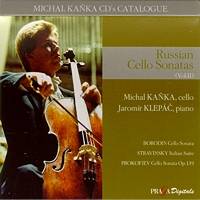
Generous lyricism
Russian cello sonatas -
investigated by
ROBERT ANDERSON'... alert and accomplished.'
|

|
Towards the end of 1859 Borodin left St Petersburg for Heidelberg at the
age of twenty-six. He was to continue his research as a chemist in a
university town that could boast such names as Bunsen (of the 'burner',
which I played with to my peril as a boy), Helmholtz and Kirchhoff,
concerned at the time with spectrum analysis. Their lectures were too
elementary for him, but he learnt much from their method of delivery and
from their experiments. His rooms had a view of the Neckar and the
mountains beyond. In May 1860 he wrote to his mother of his contentment:
'I work a lot and do it because I like it; I enjoy myself in fact. Besides
this, three times a week or even more, I play piano duets and cello duets
with a certain Mme Stutzmann, a Russian lady permanently resident in
Heidelberg. She is a good player.' This was the inspiration for the
cello sonata. Borodin himself was a good cellist, and clearly his neighbour
was a good violinist. Through the wall he was continually listening to
the Bach G minor unaccompanied violin sonata. Its fugue was adapted by
Borodin for the start of the cello sonata [listen --
track 1, 0:02-1:00]. This theme, which Borodin has managed to
Russianise, dominates much of the work. Entirely characteristic of
Borodin is the second subject, of a type familiar from the later Second
Symphony and Prince Igor [listen -- track 1,
1:23-2:32]. Only an incomplete manuscript of the sonata survives;
indeed a third of the work as performed was completed by Michael Goldstein
for publication in 1982.
Continue >>
Copyright © 13 August 2003
Robert Anderson, London UK

|

